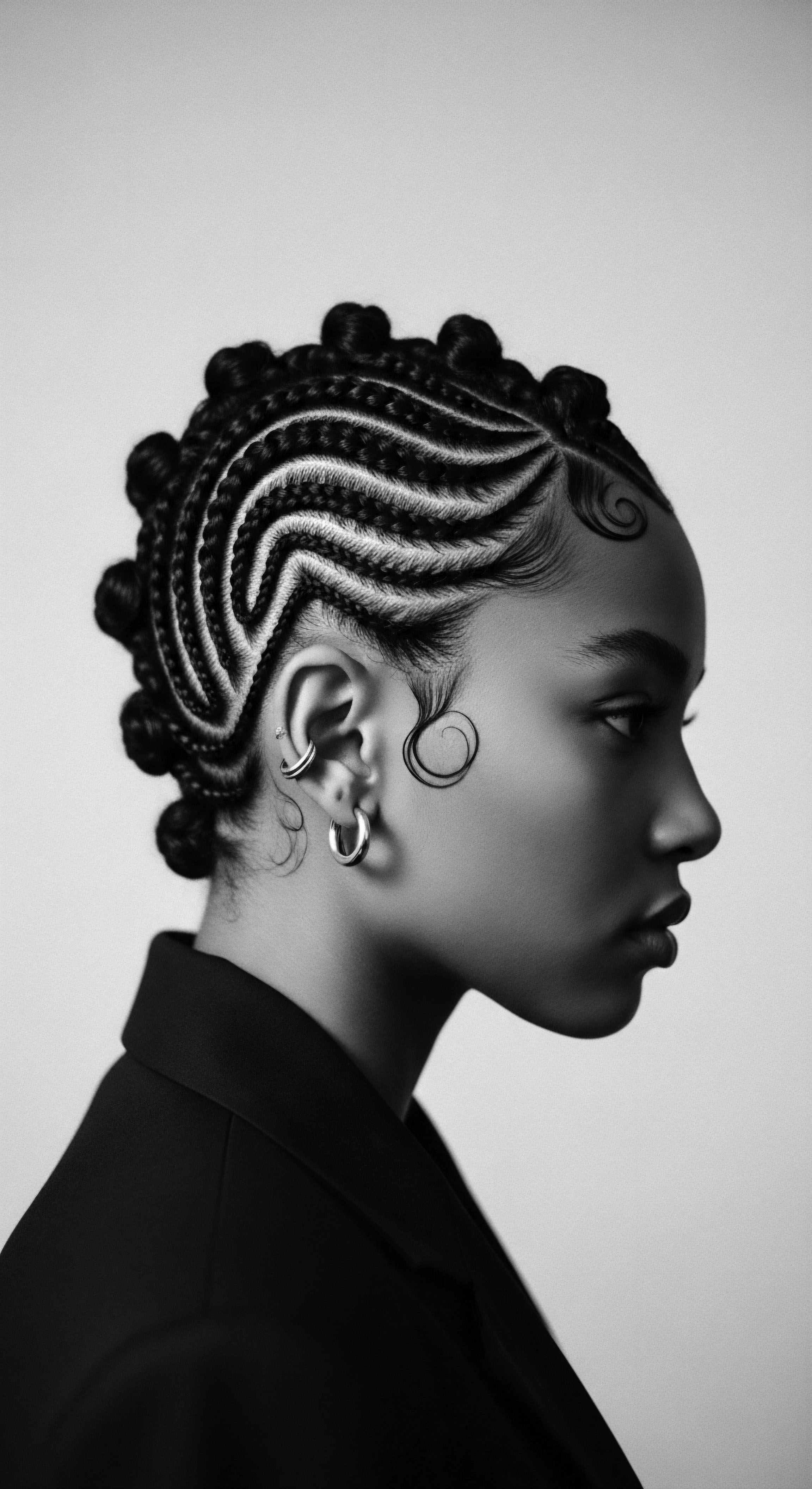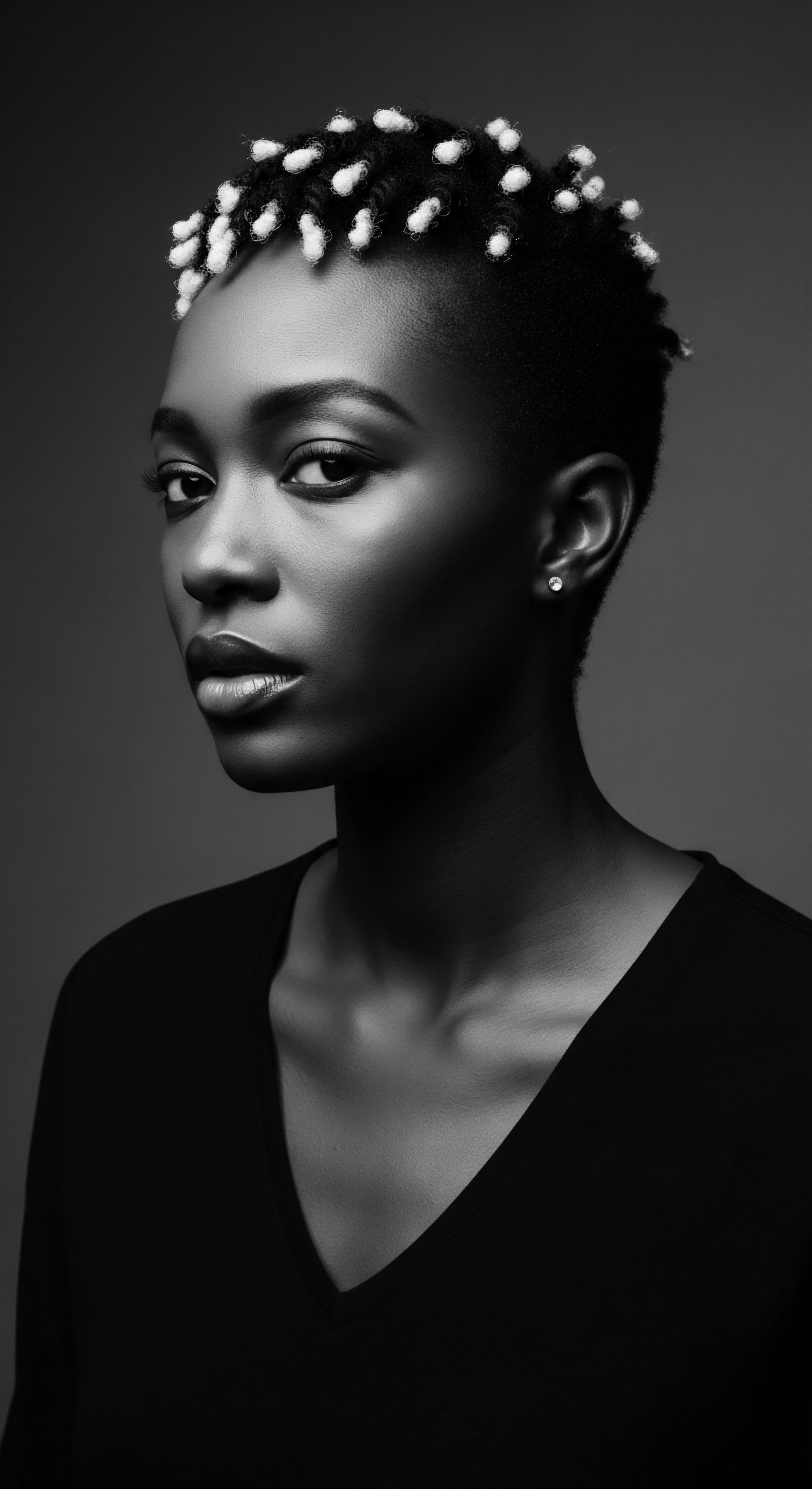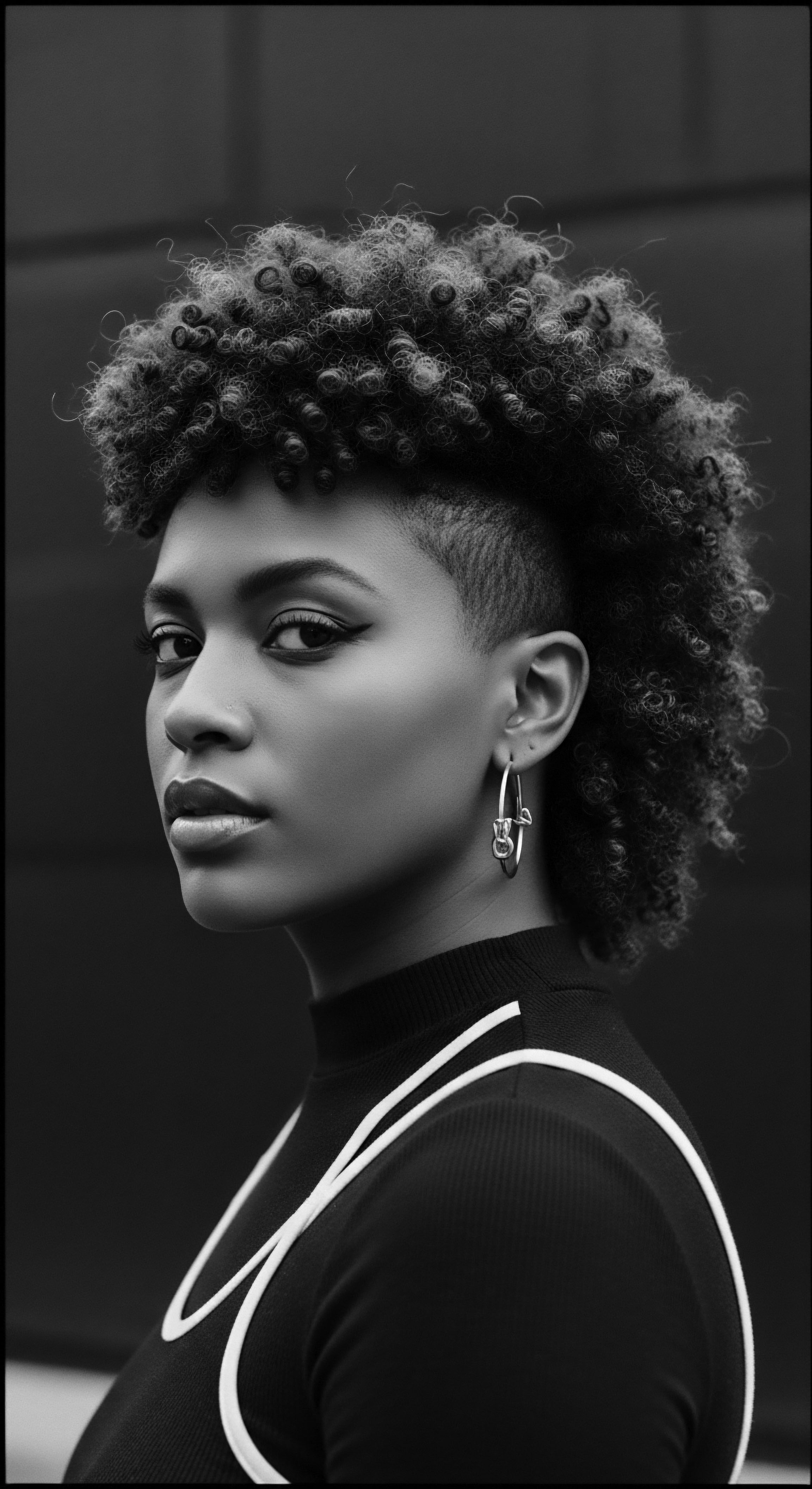
Roots
Consider a strand of textured hair, a filament spiraling with its own unique grace, carrying within its very structure the whispers of generations. For countless eons, stretching back beyond recorded scrolls and into the deep currents of human memory, the care for such hair has been a sacred act, a dialogue between the earth’s bounty and the inherent strength of one’s lineage. This tradition, steeped in the wisdom of ancestral practices, often centered on the anointing of hair with oils—a ritual that now finds a surprising, and often affirming, echo in modern scientific understanding. The question of whether contemporary research lends credence to these historical textured hair oiling practices is more than an academic exercise; it is an invitation to witness how ancient wisdom, passed down through the tender hands of mothers and grandmothers, truly holds profound truths about holistic well-being for our crowns.

Hair Anatomy and the Ancestral Veil
The architecture of textured hair, with its inherent twists and turns, creates specific requirements for moisture and protection. Unlike straighter hair forms, the helical shape of coiled strands means that the scalp’s natural oils, sebum, often struggle to descend the full length of the hair shaft, leaving the ends particularly vulnerable to dryness. This biophysical reality underpins the ancestral foresight that recognized the crucial need for external lubrication and sealing.
Many ancient cultures, from the vibrant communities of West Africa to the contemplative traditions of South Asia, intuitively understood this need, incorporating a symphony of plant-based oils and butters into their hair care regimens. These practices were not born from arbitrary custom; they arose from a deep, observant connection to the hair’s very nature and its interactions with the environment.
Textured hair’s distinct coiled structure inherently limits sebum distribution, making external oiling a practical necessity known to ancestral communities.
Consider the hair shaft itself ❉ a complex, layered column of keratinized cells. The outermost layer, the cuticle, resembles overlapping shingles. In textured hair, these cuticular scales can be more prone to lifting, which exposes the inner cortex and makes the hair more susceptible to moisture loss and external damage.
Historical oiling, therefore, served not only as a means of adding emollience but also as a protective sheath, helping to smooth these cuticular layers and fortify the strand against the elements. It is a testament to the observational acumen of our forebears, those who, without microscopes or chemical analyses, discerned the fundamental biology of hair through generations of lived experience and meticulous care.

The Essential Lexicon of Textured Hair ❉ Echoes from the Source
To speak of textured hair is to speak a language rich with history and nuance. Terms such as Coils, Kinks, and Curls describe a spectrum of patterns, each a testament to the genetic heritage carried within each individual. Beyond these descriptors, historical traditions offer their own lexicon, reflecting deep cultural connections to hair care.
- Chebe Powder ❉ A traditional mixture of herbs from the Basara Tribe in Chad, used with oils to strengthen hair strands and promote length retention.
- Champi ❉ The Hindi word for scalp massage, deeply rooted in Ayurvedic practice, emphasizing both the physical application of oils and the nurturing touch of community.
- Shiro Abhyanga ❉ In Ayurveda, this term refers to the ancient ritual of scalp oiling, valued for balancing the body’s energies and improving well-being beyond just cosmetic benefits.
These terms underscore that hair care is a holistic endeavor, encompassing not just physical attributes but also cultural significance and communal bonds. The wisdom embedded in these words guides our contemporary understanding, allowing us to see modern scientific validations as a continuation, rather than a refutation, of practices that have sustained hair health for centuries.

Ritual
The deliberate act of applying oils to textured hair has long transcended mere grooming; it has served as a ritual, a tender thread connecting individuals to their lineage and the rhythms of their communities. These are not merely steps in a routine but acts imbued with intention, passed from elder to youth, shaping identity and preserving the intrinsic beauty of textured hair. The practices, often communal and deeply personal, find their counterpart in the scientific exploration of how these natural emollients actually perform their restorative work, offering a profound continuity between historical wisdom and contemporary understanding.

Ancestral Roots of Protective Styling
Protective styles, a cornerstone of textured hair care, have been interwoven with the practice of oiling for millennia. From intricate Braids that mapped escape routes during eras of enslavement (Okpalaojiego, 2024) to culturally significant Bantu Knots and Cornrows, these styles safeguarded hair from environmental stress and manipulation. The application of oils and butters before, during, and after styling provided a vital layer of moisture and a defensive barrier.
In West African traditions, oils and butters were consistently used to maintain hydration, especially in hot, dry climates, frequently paired with protective styles to sustain length and health. This historical interplay between oiling and protective styling reveals an acute, inherited knowledge of how to preserve delicate strands against the elements and daily wear.

What Does Hair Porosity Tell Us About Historical Oiling?
Hair porosity, the ability of hair to absorb and retain moisture, plays a significant role in its interaction with oils. Textured hair often exhibits higher porosity, meaning its cuticle layers are more open, allowing moisture to enter and leave more readily. Ancestral practices, while not using the term “porosity,” effectively addressed this characteristic. For highly porous hair, thicker sealing oils were often preferred to lock in moisture, reinforcing gaps in the hair structure.
In contrast, lighter, more penetrating oils might have been favored for lower porosity textures or for scalp health. This intuitive selection of oils based on perceived hair needs suggests a deep, experiential understanding of hair’s absorptive qualities, a knowledge now articulated through the lens of modern hair science. The enduring relevance of historical oiling practices for textured hair is evident in how they provided essential moisture and protection.

The Tender Thread of Tools and Techniques
The tools used in historical hair oiling were extensions of the hands, often crafted from nature’s materials. Smooth wooden combs, carved bone picks, and even one’s own fingers served to gently distribute oils and detangle strands. The application techniques themselves varied, but often involved massaging oils into the scalp and working them down the hair shaft.
This massage not only aided in product distribution but was also understood to stimulate the scalp, a practice now recognized for its potential to improve blood flow to hair follicles. The communal aspect of oiling, where family members often cared for one another’s hair, underscores the cultural rather than purely cosmetic nature of these practices.
Consider the Himba Tribe of Namibia, whose women are renowned for their distinctive hair care. They traditionally coat their thick, luscious hair in a mixture known as ‘otjize’—a paste of ochre, butterfat, and aromatic resins. This blend serves multiple functions ❉ protection from the sun, insect repellent, and a symbol of beauty and status.
While not a liquid oil in the conventional sense, the butterfat component functions similarly to an oil, providing intense moisturization and a protective barrier against the harsh arid climate. This intricate ritual, passed through generations, speaks volumes about ancestral ingenuity in adapting local resources for comprehensive hair care, merging utility with identity and aesthetic expression.
| Historical Context West African Traditions (e.g. Shea Belt) |
| Traditional Oils and Their Purpose Shea butter and other plant butters used for moisture retention, scalp health, and protection in hot, dry climates. Often applied with protective styles. |
| Modern Scientific Understanding Rich in fatty acids, provides occlusive barrier, and anti-inflammatory benefits, sealing moisture and aiding elasticity. |
| Historical Context Ancient India (Ayurveda) |
| Traditional Oils and Their Purpose Coconut oil and sesame oil infused with herbs, massaged into scalp and hair for strength, growth, and balancing energies. |
| Modern Scientific Understanding Coconut oil penetrates hair shaft, reducing protein loss and hygral fatigue. Sesame oil has antioxidant properties. |
| Historical Context Indigenous North American Practices |
| Traditional Oils and Their Purpose Jojoba oil for scalp care and hair health. |
| Modern Scientific Understanding Jojoba oil mimics natural sebum, balancing scalp oils, moisturizing hair, and preventing breakage. |
| Historical Context These examples reveal a timeless wisdom in hair care, where ancestral practices often align with contemporary scientific insights regarding natural oil benefits for textured hair. |

Relay
The generational relay of textured hair oiling practices, a lineage of care spanning continents and epochs, is not merely a collection of anecdotes. Beneath the surface of these inherited rituals lies a robust interplay of biochemistry and biophysics, increasingly substantiated by scientific inquiry. The modern laboratory, in its meticulous dissection of molecular structures and their interactions, frequently provides validation for the efficacy observed in traditional applications, creating a powerful testament to the enduring foresight of ancestral wisdom.

Does Scientific Research Validate Historical Textured Hair Oiling?
Indeed, scientific research provides compelling support for many traditional textured hair oiling practices. The molecular makeup of certain natural oils allows them to interact with hair fibers in ways that directly address the specific needs of textured hair. For instance, studies have shown that Coconut Oil, with its low molecular weight and straight linear chain structure, possesses a unique ability to penetrate the hair shaft. This penetration is crucial because it goes beyond simply coating the surface.
Once inside the hair, coconut oil can reduce protein loss in both damaged and undamaged hair, a significant finding given that protein loss is a primary contributor to hair weakness and breakage. Furthermore, coconut oil can decrease the amount of swelling that occurs when hair is saturated with water, a phenomenon known as hygral fatigue. By mitigating this constant expansion and contraction, coconut oil helps preserve the hair’s structural integrity over time. This scientific explanation provides a profound grounding for the historical use of coconut oil as a pre-wash treatment, a practice prevalent in South Asian traditions, aiming to fortify hair against the rigors of washing.
Many historical hair oiling methods gain scientific validation, with specific oils demonstrating a capacity to penetrate hair, reduce protein loss, and mitigate hygral fatigue.

The Efficacy of Specific Oils and Their Heritage Connections
While coconut oil garners significant scientific attention for its penetrative qualities, other oils long cherished in textured hair heritage also reveal benefits.
- Shea Butter, a staple in West African hair care for centuries, is rich in fatty acids and vitamins A and E. Its occlusive nature creates a protective barrier on the hair shaft, sealing in moisture and guarding against environmental stressors. This aligns with its traditional use for nourishing and moisturizing hair, particularly in harsh climates.
- Jojoba Oil, historically valued by Indigenous cultures for scalp care, stands out due to its molecular similarity to human sebum, the natural oil produced by our scalps. This characteristic allows jojoba oil to help balance scalp oil production, moisturize strands without clogging pores, and provide anti-inflammatory and antimicrobial properties beneficial for scalp health. Its historical application for scalp well-being is thereby scientifically supported by its biomimetic qualities.
- Castor Oil, another oil with deep historical roots, particularly in African and ancient Egyptian beauty regimens, is often used for its purported ability to promote hair growth and thicken strands. While scientific evidence directly supporting its role in hair growth remains limited, it is rich in ricinoleic acid, a fatty acid with anti-inflammatory properties that may contribute to a healthier scalp environment. It also effectively provides a thick, occlusive coating, offering shine, preventing breakage, and acting as a sealant for moisture. The long-standing anecdotal evidence for castor oil’s benefits finds scientific explanation in its ability to condition and protect the existing hair.
One illuminating example of the scientific support for ancestral practices comes from a systematic review by Phong et al. (2022). This comprehensive review examined various studies on the effects of coconut, castor, and argan oils on hair health, particularly in individuals with skin of color. The review concluded that Coconut Oil Showed Clear Evidence of Reducing Hair Breakage by 41.8%, improving scalp hydration, and minimizing protein loss and water absorption.
This quantitative data directly supports the centuries-old observation that regular application of coconut oil leads to stronger, healthier hair, especially for textured hair types more prone to breakage. Such findings bridge the gap between inherited wisdom and contemporary validation, affirming the efficacy of these time-honored rituals.
The scientific lens helps us understand why these practices worked so effectively, even when the underlying mechanisms were not explicitly known by our ancestors. The synergy between oil composition, hair structure, and environmental factors creates a nuanced picture of hair care. The ancestral reliance on specific plant-based oils was not arbitrary but rather a response to the inherent characteristics of textured hair and the desire to preserve its vitality and beauty across generations.

Reflection
The dialogue between historical wisdom and scientific inquiry, particularly concerning textured hair oiling, paints a compelling portrait of endurance and insight. From the communal embrace of Champi in South Asian homes to the protective traditions of West African villages, these practices were more than mere acts of self-beautification. They were profound expressions of identity, connection to heritage, and an intuitive understanding of hair’s needs. We stand today at a beautiful crossroads, where the modern laboratory, with its precise measurements and molecular insights, can confirm the deep efficacy of what our ancestors knew through generations of lived experience.
The enduring legacy of textured hair oiling is not just about the physical benefits; it is about recognizing the ingenuity, the reverence, and the profound love woven into every strand, a testament to the resilience of traditions that continue to shape our relationship with our hair and ourselves. This knowledge, now amplified by scientific validation, helps us to carry forward the Soul of a Strand, honoring its past while nurturing its future.

References
- Okpalaojiego, J. (2024). The Remarkable History Behind Black Hairstyles. University of Salford Students’ Union.
- Phong, H. Y. et al. (2022). Coconut, Castor, and Argan Oil for Hair in Skin of Color Patients ❉ A Systematic Review. Journal of Drugs in Dermatology, 21(7), 751-757.
- Rele, V. K. & Mohile, R. B. (2003). Effect of mineral oil, sunflower oil, and coconut oil on prevention of hair damage. Journal of Cosmetic Science, 54(2), 175-192.
- Ruetsch, S. B. et al. (2001). Secondary ion mass spectrometric investigation of penetration of coconut and mineral oils into human hair fibers ❉ Relevance to hair damage. Journal of Cosmetic Science, 52(3), 169-181.
- Dias, M. F. R. G. (2015). Hair Cosmetics ❉ An Overview. International Journal of Trichology, 7(1), 2-15. (General information on hair properties and ingredients)
- Gopinath, H. & Mohan, R. B. (2018). Penetration of vegetable oils into textured hair fibers ❉ Integrating molecular matrix assisted laser desorption ionization time-of-flight mass spectroscopy (MALDI TOF/TOF MS) analysis with mechanical measurements. Cosmetics, 5(2), 26.
- Gavazzoni, M. (2012). The History of Hair Care. Journal of the American Academy of Dermatology, 66(4), AB20.
- Bupatty, S. & Shivananda, B. R. (2013). Hair and Scalp Care in Ayurveda. Journal of Clinical & Diagnostic Research, 7(12), 2955-2957.
- Burt, S. (2004). Essential oils ❉ their antibacterial and antifungal properties in cosmetics. International Journal of Cosmetic Science, 26(3), 133-144.
- Pazyar, N. et al. (2013). Jojoba in dermatology ❉ A review. Journal of Traditional and Complementary Medicine, 3(1), 47-53.
